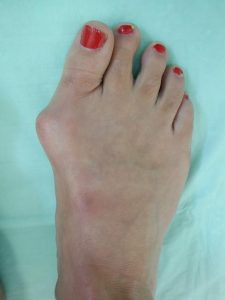
Anyone can get a bunion, but they are more common in women. Many women wear tight, narrow shoes that squeeze the toes together—which makes it more likely for a bunion to develop, worsen, and cause painful symptoms. Bunions that occur in young people are called "adolescent bunions." These bunions are most common in girls between the ages of 10 and 15 and are hereditary.
Bunions start out small and slowly but they usually get worse over time. As the big toe angles toward the second toe, it can cross over it and cause additional problems An advanced bunion can greatly alter the appearance of the foot. The big toe may angle all the way under or over the second toe. Pressure from the big toe may force the second toe out of alignment, causing it to come in contact with the third toe. Calluses may develop where the toes rub against each other, causing difficulty in wearing shoes, pain, and difficulty walking.
Reproduced from Wagner E, Ortiz C: Proximal Oblique Sliding Closing-wedge Osteotomy for Wide-angle Hallux Valgus.
Orthopedic Knowledge Online Journal: Vol 12, No 4, 4/1/2014; Accessed December 4, 2015.
In addition to the visible bump on the inside of the foot, symptoms of a bunion may include:
- Pain and tenderness around the big toe.
- Redness and inflammation.
- Hardened skin on the bottom of the foot.
- A callus on the bump.
- Stiffness and loss of motion in the big toe joint making walking painful
The alignment of your foot can change when you stand or sit. A weight-bearing x-ray will show any malalignment of the bones of your foot. Your physician may recommend surgery for a bunion or bunionette if other conservative treatments have failed to relieve pain and or difficulty with walking. Bunion surgery realigns bone, ligaments, tendons, and nerves so that the big toe can be brought back to its correct position. Even if you have had bunion surgery, it is important to protect and support the foot from the biomechanical stresses that helped create the Bunion in the first place or the bunion may return over time. If an adolescent has bunion surgery, particularly before reaching skeletal maturity, there is a strong chance the Bunion will return.
In many cases, bunions are treated without surgery. Although nonsurgical treatment cannot actually "reverse" a bunion, it can help reduce pain and keep the bunion from worsening. Shoe type, fit, and construction, as well as support inside the shoe (orthotic support), are keys to relieving bunion pain and restoring proper foot mechanics. Bunion pain can be managed successfully by wearing properly fitting shoes that match anatomy, do not compress the toes, and utilizing foot type-specific orthotics.
Sole Remedy specializes in gait analysis, foot type assessment, musculoskeletal injury management and fall prevention.
Phone: 508-295-8800 or 855-FOOT RX 9 to schedule an appointment today!
